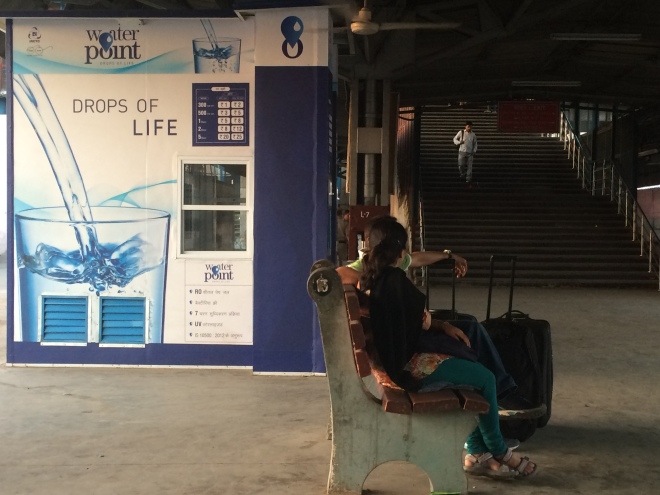Water has become a scarce resource in India. Around a quarter of the Indian population has suffered from this year’s drought, affecting more than 330 million people, 313 districts and 158,205 villages. As per the Central Water Commission data, the country’s major reservoirs are 79% empty. The data by the Water Footprint Network (PDF) reveals that while India is a top water virtual exporter, 97% of its population is experiencing severe water scarcity at least one month of the year.

Heat stroke deaths
This summer has seen several water scarcity-related accidents and heat strokes deaths reported: Five men died after inhaling poisonous gases while trying to restore a well in Haryana, and a twelve-year-old died of heat stroke at a water pump in Maharashtra after doing five trips in search of water.
Heat waves set records last May in India, with a maximum temperature of 51 degrees Celsius recorded in Phalodi, a town in Rajasthan, the highest temperature ever recorded in the country. Besides, the toll of the number of lives lost due to heat strokes has increased over the last years in India.
Access to water and sanitation
The Census statistics of the last four decades in India suggests a notable overall improvement in the access to safe drinking water to households. However, in some parts of the territory a signficant percentage of households remains with no access to potable water.
97% of the population is experiencing severe water scarcity at least one month of the year, according to a report by the Water Footprint Network. Water scarcity limits the opportunities for reducing the number of undernourished people. India tops the world hunger list, with 194 million undernourished people. Moreover, the lack of access to potable water and sewerage services result in a higher risk for the population of contracting water-related diseases. The World Bank says 21% of communicable diseases in India are water related, and the Global Health Observatory (GHO) data estimates that diarrhea is the third major cause of child mortality in India, accounting for the 13% of all deaths among children aged below 5 years.
The rural exodus in search of water
Due to water scarcity, farmers are forced to find alternative ways to earn their living and they are moving from rural areas to the cities where they can earn triple, as shown by a survey conducted by IndiaSpend to 60 migrant families, most of them farmers coming from rural areas to Mumbai where they work at construction sites. Drought relief camps have been set up in largest cities for water refugees.
A survey by National Sample Survey Office (NSSO) conducted for the agricultural year 2012-13 said that the average monthly income per agricultural household in India is Rs.6426/-. This data sheds light on the harsh socio-economic conditions that Indian farmers have to cope with, being this situation exacerbated by the scarcity of water since the harvest depends on irrigation, water availability and rainfall.

India is a top virtual water exporter
In this severe water scarcity conditions, exports and trade put pressure on the local water resources that goes beyond sustainable limits, according to the already mentioned report by the Water Footprint Network. The study says that India is the second top net virtual blue water exporter (net virtual water exporters use their internal water resources to produce goods and services that are consumed outside their borders). In other words, India is exporting large amounts of freshwater by using its scarce natural resource for the production of goods and commodities that are then exported.
India tops the list of annual freshwater withdrawals with 761 billion cubic meters in the World Bank data of 2011-2015. Nevertheless, according to FAO 90.41% of total water withdrawal is withdrawn for agriculture while domestic usage accounts for less than 5% of the annual consumption. This data reveals that one of the reasons to which this water scarcity situation is ascribed is the production of water-intensive crops and increased demand of water for agriculture commodities production. In 2015, for instance, India was the largest exporter of rice in the world with a total of 10.23 million tons.
As reported in The Hindu, crop subsidies and skewed agriculture produce market that rewards farmers who cultivate unsuitably water-intensive crops such as sugarcane and other cash crops, and this plays against water conservation and its renewable capacity. Experts and activists insist on the importance of supporting cultivation of indigenous varieties of crops that are drought resistant by supporting alternative models of production that prioritise local economies. The Peasants’ organisation All India Kisan Mazdoor Sabha (AIKMS) declared to The Hindu that would start a campaign in India “to create public awareness against provision of large quantity of water to units of large corporate houses while allowing farmers and the downtrodden to suffer in severe water crisis”.
A recent research paper by scientists from Kerala and Pune and reported by the Indian Express says that India “may have to brace for more frequent drought years in the future”. Floods and droughts are linked and have to be understood as part of the same cycle -has been pointed out by experts. A reminder for not forgetting the disaster when the summer is coming to an end with the arrival of the monsoon rains in mid-June.